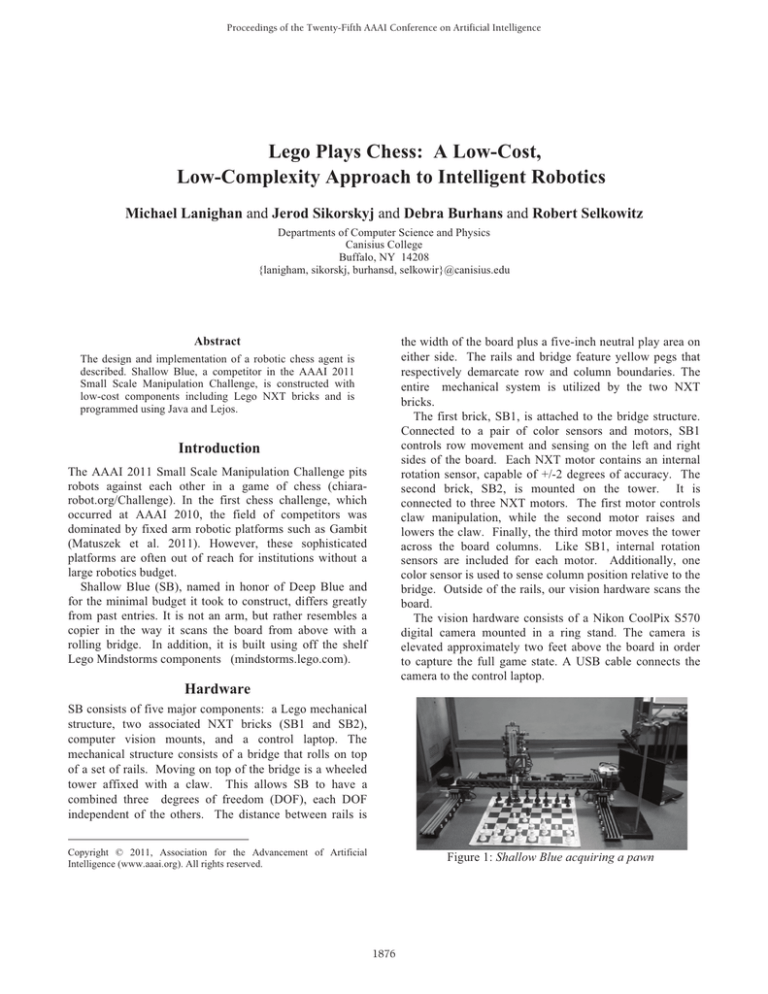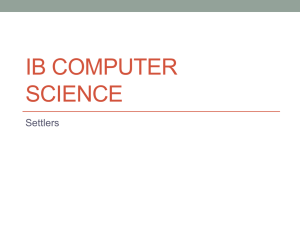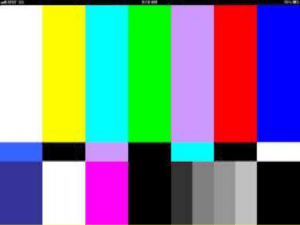
Proceedings of the Twenty-Fifth AAAI Conference on Artificial Intelligence
Lego Plays Chess: A Low-Cost,
Low-Complexity Approach to Intelligent Robotics
Michael Lanighan and Jerod Sikorskyj and Debra Burhans and Robert Selkowitz
Departments of Computer Science and Physics
Canisius College
Buffalo, NY 14208
{lanigham, sikorskj, burhansd, selkowir}@canisius.edu
the width of the board plus a five-inch neutral play area on
either side. The rails and bridge feature yellow pegs that
respectively demarcate row and column boundaries. The
entire mechanical system is utilized by the two NXT
bricks.
The first brick, SB1, is attached to the bridge structure.
Connected to a pair of color sensors and motors, SB1
controls row movement and sensing on the left and right
sides of the board. Each NXT motor contains an internal
rotation sensor, capable of +/-2 degrees of accuracy. The
second brick, SB2, is mounted on the tower. It is
connected to three NXT motors. The first motor controls
claw manipulation, while the second motor raises and
lowers the claw. Finally, the third motor moves the tower
across the board columns. Like SB1, internal rotation
sensors are included for each motor. Additionally, one
color sensor is used to sense column position relative to the
bridge. Outside of the rails, our vision hardware scans the
board.
The vision hardware consists of a Nikon CoolPix S570
digital camera mounted in a ring stand. The camera is
elevated approximately two feet above the board in order
to capture the full game state. A USB cable connects the
camera to the control laptop.
Abstract
The design and implementation of a robotic chess agent is
described. Shallow Blue, a competitor in the AAAI 2011
Small Scale Manipulation Challenge, is constructed with
low-cost components including Lego NXT bricks and is
programmed using Java and Lejos.
Introduction
The AAAI 2011 Small Scale Manipulation Challenge pits
robots against each other in a game of chess (chiararobot.org/Challenge). In the first chess challenge, which
occurred at AAAI 2010, the field of competitors was
dominated by fixed arm robotic platforms such as Gambit
(Matuszek et al. 2011). However, these sophisticated
platforms are often out of reach for institutions without a
large robotics budget.
Shallow Blue (SB), named in honor of Deep Blue and
for the minimal budget it took to construct, differs greatly
from past entries. It is not an arm, but rather resembles a
copier in the way it scans the board from above with a
rolling bridge. In addition, it is built using off the shelf
Lego Mindstorms components (mindstorms.lego.com).
Hardware
SB consists of five major components: a Lego mechanical
structure, two associated NXT bricks (SB1 and SB2),
computer vision mounts, and a control laptop. The
mechanical structure consists of a bridge that rolls on top
of a set of rails. Moving on top of the bridge is a wheeled
tower affixed with a claw. This allows SB to have a
combined three degrees of freedom (DOF), each DOF
independent of the others. The distance between rails is
Copyright © 2011, Association for the Advancement of Artificial
Intelligence (www.aaai.org). All rights reserved.
Figure 1: Shallow Blue acquiring a pawn
1876
selected
two
free
engines,
Houdini
1.5a
(http://www.cruxis.com/chess/houdini.htm) (closed source)
and Stockfish 2.0.1 (www.stockfishchess.com) (open
source), respectively ranked #2 and #3 worldwide for time
controls
of
forty
moves
in
four
minutes
(computerchess.org.uk).
These chess engines, both
advanced alpha-beta searchers, run on the control laptop.
Custom-designed control software will parse engine
output, store game-state details, and send the next move to
our movement subsystem. This chess decision subsystem
allows for maximum flexibility to use the best and fastest
available chess engines right up to competition
deployment. To predict a legal move, the chess decision
subsystem will need an accurate vision subsystem for
board state recognition.
Preliminary work on vision includes parsing camera
images using ImageJ and OpenCV. Both can be called
from the MCP using Java. The major challenge is
detection of the initial board state, which can be mid-game.
Move detection involves change between sequential
images (for example, as described in the paper by Sokic
and Ahic-Djokic 2008). Initial results suggest that the
addition of NXT-connected color sensors and IR distance
sensors mounted underneath the bridge may aid in piece
recognition.
The control laptop, a Dell Latitude E4500, sits outside
the mechanical structure.
Utilizing an Abe UB22S
Bluetooth dongle, the laptop wirelessly communicates with
the NXT Bricks. This computer centrally connects the
hardware and software of the system.
Software
The software system is divided into four major subsystems:
the Master Control Program (MCP), movement subsystems
SB1 and SB2, chess reasoning, and vision. SB utilizes
Java 1.6.0_21 for the MCP. SB1 and SB2 use LeJOS
0.85a, a firmware replacement for Lego Mindstorm NXT
robots that provides a Java-based programming
environment (lejos.sourceforge.net).
The chess reasoning subsystem utilizes a Universal
Chess Interface (UCI) engine binary coupled with Javabased control software. Prototypes of the vision software
subsystem use OpenCV (opencv.willowgarage.com) and
ImageJ (rsbweb.nih.gov/ij), open-source computer vision
libraries.
The computationally intensive subsystems of SB, such
as the MCP, chess reasoning, and vision are run on the
control laptop. By coordinating these separate subsystems,
the MCP enables enhanced computing power and
flexibility not available on an NXT brick. This centralized
design allows for the optional use of additional external
computing resources, such as a cluster. Additionally, the
MCP acts as a host to the brick-based programs, SB1 and
SB2, communicating which piece to move.
SB1 and SB2 each contain a listener NXT program and
corresponding motor control logic to move the mechanical
structure. The SB1 subsystem controls row movement
while the SB2 subsystem controls both column and claw
movement. In each case, the MCP wirelessly coordinates
these movement subsystems for piece acquisition through
Bluetooth.
Piece acquisition, however, needs to be informed by the
chess engine before it can be initiated. Competition rules
necessitate that choosing and physically completing each
move must be done within two minutes. Utilizing existing
chess software is prudent given the fact that designing a
fast, grandmaster level computer chess program is not the
goal of the competition.
Contemporary computer chess programs have evolved to
have two major components: a chess engine where
calculating the next best move is completed and a chess
user interface that allows for player input/output, detailed
game-state storage, and display. Communication protocols
have been invented to talk between these two components
(www.horizonchess.com). The three dominant protocols
are:
ChessBase, WinBoard/Xboard, and UCI
(www.shredderchess.com). ChessBase is a closed protocol
system while WinBoard/Xboard and UCI are both open.
The world’s top five chess engines all utilize UCI, while
only some of those five use the other protocols. We
Conclusion
Although not infinitely applicable outside of chess, SB
would easily transition to other styles of board games. The
system could be applicable in industrial overhead systems,
albeit with different components. Most importantly though,
is that SB is proof that anyone, in theory, can build an
intelligent robotic system on a minimal budget.
References
Matuszek, C., Mayton, B., Aimi, R., Deisenroth, M.P., Bo,
L., Chu, R., Kung, M., LeGrand, L., Smith, J.R., Fox, D.
2011. Gambit: A Robust Chess-Playing Robotic System.
To appear in Proceedings of ICRA 2011. Shanghai, China:
IEEE.
Sokic, E. and Ahic-Djokic, M. 2008. Simple Computer
Vision System for Chess Playing Robot Manipulator as a
Project-based Learning Example. In Signal Processing
and Information Technology, 2008. ISSPIT 2008, 75-79.
Sarajevo, Bosnia and Herzegovina: IEEE.
Acknowledgments
Special thanks to the Canisius College CSC360: Intelligent
Systems class (Spring 2011), as well as the Physics and
Computer Science departments, especially Matthew Hertz.
1877



